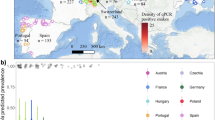Abstract
The infective third stage larvae of hookworms infect their hosts by active skin invasion, and they find and recognize their hosts by the behavioural phases of activation, directed crawling, and penetration. Here we analyse the orientation of the infective larvae of the human hookworms Necator americanus and Ancylostoma duodenale when crawling on surfaces. Their behaviour differed from that of the larvae of the dog hookworm Ancylostoma caninum, but the two species also differed from each other. N. americanus crawled towards light, but A. duodenale did not. Both species migrated towards the warm ends of thermal gradients, and this response was more sensitive than in other skin-invading helminths (threshold 0.09°C/cm). However, A. duodenale turned back and accumulated at higher temperatures than N. americanus [turn-back 45.7 (44.5–49.9) vs 41.5 (38.5–43.9)°C; accumulation 43.6 (41.6–46.0) vs 39.5 (37.9–43.0)°C]. In contrast to other skin-invading helminths, both species showed no chemo-orientation towards skin compounds when crawling on surfaces. This behaviour may reflect adaptations for reaching the skin surface from hairs or adhering material, but the differences in the orientation of the two species could not be attributed to differing transmission strategies.



Similar content being viewed by others
References
Alexander RM (2002) Locomotion. In: Lee DL (ed) The biology of nematodes. Taylor and Francis, London, pp 345–352
Bhopale VM, Kupprion EK, Ashton FT, Boston R, Schad GA (2001) Ancylostoma caninum: the finger cell neurons mediate thermotactic behavior by infective larvae of the dog hookworm. Exp Parasitol 97:70–76
Campbell JF, Lewis EE (2002) Entomopathogenic nematode host-search strategies. In: Lewis EE, Campbell JF, Sukhdeo MVK (eds) The behavioural ecology of parasites. CAB International, Wallingford, pp 13–38
Granzer M, Haas W (1991) Host finding and host recognition of infective Ancylostoma caninum larvae. Int J Parasitol 21:429–440
Haas W (1994) Physiological analyses of host-finding behaviour in trematode cercariae: adaptations for transmission success. Parasitology 109:S15-S29
Haas W (2003) Parasitic worms: strategies of host finding, recognition and invasion. Zoology 106:349–364
Haas W, Granzer M, Garcia EG (1987) Host identification by Schistosoma japonicum cercariae. J Parasitol 73:568–577
Haas W, Granzer M, Brockelman C (1990) Finding and recognition of the bovine host by the cercariae of Schistosoma spindale. Parasitol Res 76:343–350
Haas W, Haberl B, Schmalfuss G, Khayyal MT (1994) Schistosoma haematobium cercarial host-finding and host-recognition differs from that of S. mansoni. J Parasitol 80:345–353
Haas W, Grabe K, Geis C, Päch T, Stoll K, Fuchs M, Haberl B, Loy C (2002) Recognition and invasion of human skin by Schistosoma mansoni cercariae: the key-role of L-arginine. Parasitology 124:153–167
Hoagland KE, Schad GA (1978) Necator americanus and Ancylostoma duodenale: life history parameters and epidemiological implications of two sympatric hookworms of humans. Exp Parasitol 44:36–49
Ishibashi N (2002) Behaviour of entomopathogenic nematodes. In: Lee DL (ed) The biology of nematodes. Taylor and Francis, London, pp 511–520
Lee DL (2002) Behaviour. In: Lee DL (ed) The biology of nematodes. Taylor and Francis, London, pp 369–387
Li J, Zhu X, Boston R, Ashton FT, Gamble HR, Schad GA (2000) Thermotaxis and thermosensory neurons in infective larvae of Haemonchus contortus, a passively ingested nematode parasite. J Comp Neurol 424:58–73
Mangali A, Sasabone P, Syafruddin, Abadi K, Hasegawa H, Toma T, Kamimura K, Miyagi I (1993) Intestinal parasitic infections in Campalagian District, South Sulawesi, Indonesia. Southeast Asian J Trop Med Public Health 24:313–320
McCue JF, Thorson RE (1964) Behavior of parasitic stages of helminths in a thermal gradient. J Parasitol 50:67–71
Schad GA (1991) The parasite. In: Gilles HM, Ball PAJ (eds) Hookworm infections. Elsevier, Amsterdam, pp 15–49
Sciacca J, Forbes WM, Ashton FT, Lombardini E, Gamble HR, Schad GA (2002a) Response to carbon dioxide by the infective larvae of three species of parasitic nematodes. Parasitol Int 51:53–62
Sciacca J, Ketschek A, Forbes WM, Boston R, Guerrero J, Ashton FT, Gamble HR, Schad GA (2002b) Vertical migration by the infective larvae of three species of parasitic nematodes: is the behaviour really a response to gravity? Parasitology 125:553–560
Acknowledgements
This work was carried out at the Research Center of Hasanuddin University, Makassar, Indonesia and at the Institute for Zoology, Erlangen, Germany. We thank our Indonesian counterparts Drs. A. Mangali, I. Patellongi, A.M. Afdal, E.Y. Singka and the members of their teams for their valuable help with the field surveys and the sample collections and Christina Loy and Bety Sapada for their expert technical work. We also wish to thank Professor Gerhard Schad for advising and encouraging us during this project. This work was supported by the Deutsche Forschungsgemeinschaft, the Bundesministerium für wirtschaftliche Zusammenarbeit und Entwicklung, and DAAD. The experiments performed in this work comply with the current laws of Germany and Indonesia.
Author information
Authors and Affiliations
Corresponding author
Rights and permissions
About this article
Cite this article
Haas, W., Haberl, B., Syafruddin et al. Infective larvae of the human hookworms Necator americanus and Ancylostoma duodenale differ in their orientation behaviour when crawling on surfaces. Parasitol Res 95, 25–29 (2005). https://doi.org/10.1007/s00436-004-1256-8
Received:
Accepted:
Published:
Issue Date:
DOI: https://doi.org/10.1007/s00436-004-1256-8




